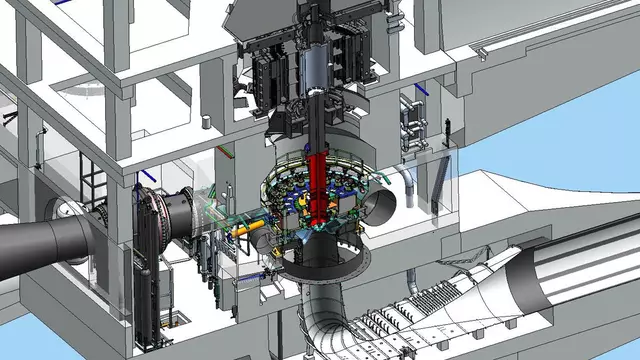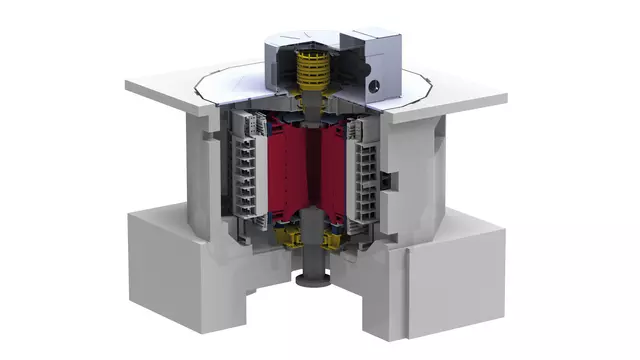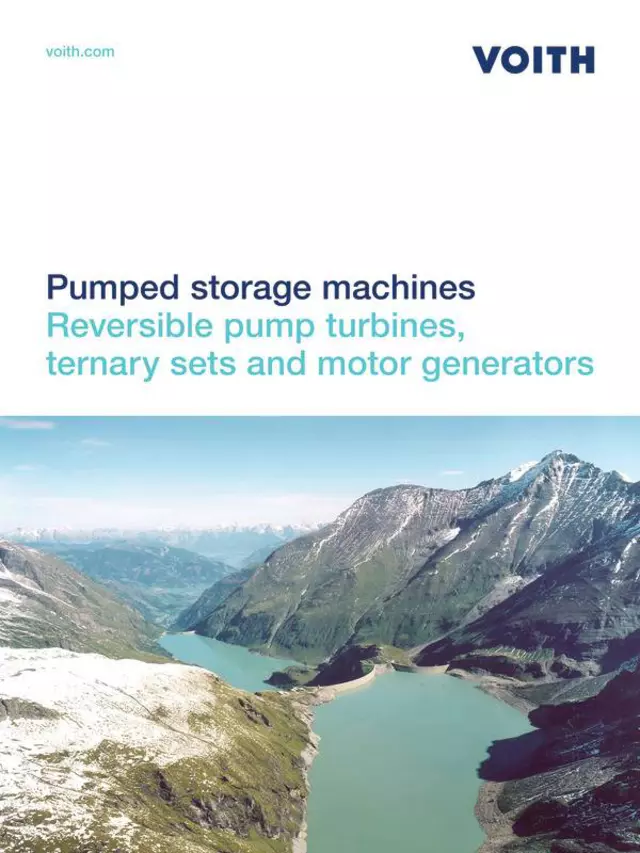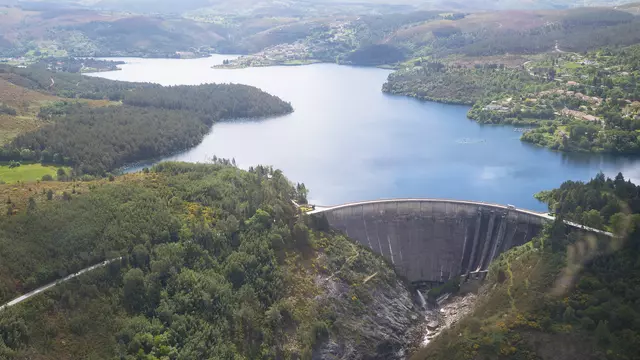Pumped storage plantsHydropower plant plus energy storage
Pumped storage plants are multi-functional
Energy consumption is rapidly increasing. At the same time, it is becoming harder to keep energy production and consumption in balance at all times. As multi-functional power plants, pumped storage facilities have a high potential to meet this challenge, because their technology is based on the only long-term, technically proven and cost-effective form of storing energy on a large scale, thereby making it available at short notice.

450 pumped storage units installed worldwide by Voith
In 1937, Voith developed the first large, single-stage pump turbine, which operated both as a turbine for energy generation and in the reverse direction as a pump. Today, nearly 450 Voith pump turbines have been installed worldwide with a combined output of more than 60 000 megawatts. With a wide range of specific speeds, pump turbines can be installed at sites with heads up to 800 meters and with unit capacities ranging from less than 10 to 500 megawatts. Voith is continually advancing its state-of-the-art technological capabilities with developments that include variable-speed technology and wide head range applications. These machines have proven extremely reliable in practical operation.
The advantages of pumped storage plants:
- Flexible and reliable: Pumped storage plants are able to react to grid fluctuations in the shortest possible time by generating the required electricity or by absorbing any excess
- Reserve output at low wind or lack of sunshine
- "Green battery": With the current stage of technology, pumped storage is the only possibility to store energy in an economically viable, large-scale way
- High economical value: Pumped storage plants work at an efficiency level of up to 82 percent
- Water resource management and flood control
- Exceptional lifetime of more than 80 years
- Hybrid concepts: Combining pumped storage and wind or solar
- Symbiotic concepts: Renewable power and clean fresh water
Hybrid and symbiotic concepts offer new opportunities
Hybrid solutions – such pumped storage power plants combined with wind and/or solar farms – are becoming increasingly important for the generation and storage of clean, renewable energy, as well as in the production of drinking water.
With the innovative concept of combining wind power and hydropower together, the upper basin is integrated into the foundation of the wind turbine towers. Planning and infrastructure costs, as well as environmental impact, can be reduced as the two technologies use the same grid connection and switchgear.
Combining the technologies creates new trading alternatives that are not possible in a pure wind farm operation. This is expanding the potential of decentralized pumped storage.
Should the wind turbines deliver more energy than needed, water is pumped from the lower basin into the upper basin of the wind turbines. If there is no wind blowing or a higher demand of energy arises, the water flows from the upper basin through the turbine into the lower basin. This will drive a turbine that will generate via the connected motor generator electricity and release it into the grid.

The use of saltwater for pumped storage plants with the ocean as the lower reservoir, instead of using precious fresh water, offers a huge potential. This symbiotic saltwater concept could be an application for small grids on islands. The challenges of protecting equipment against corrosion can be solved technically.
By combining a seawater pumped storage system and a desalination plant, using reverse osmosis (RO) to turn seawater into drinking water, we can help provide fresh water in arid coastal areas and environmentally friendly energy at the same time. The ocean would be used as the lower reservoir, with the upper reservoir in nearby coastal mountains.


The webcast will compare lithium-ion (Li-ion) batteries with pumped storage hydropower. Topics will concentrate on raw materials, investment costs and CO2 footprints.
Dr. Krueger has worked at several national and international thermal and hydropower plants and in different management positions.

The operating principle –
both simple and ingenious
The principle behind the operation of pumped storage power plants is both simple and ingenious. Their special feature: They are an energy store and a hydroelectric power plant in one. If there is a surplus of power in the grid, the pumped storage power station switches to pumping mode – an electric motor drives the pump turbines, which pumps water from a lower reservoir to a higher storage basin. If the demand for electricity in the grid rises, water is released from the upper basin via a pressure pipeline to the bottom. The water causes the pump turbines to rotate, now operating in turbine mode and used to drive the generators. Within seconds, electricity is generated and fed into the grid.

Storage of electricity –
pump operation
pump operation
- Power is taken from the power grid to run the electric motor.
- The electric motor drives the pump turbine.
- The water from the lower basin is pumped into the upper basin.

Generation of electricity –
turbine operation
turbine operation
- The water is fed from the upper basin through a penstock to the pump turbine and drives it.
- The turbine drives the generator, which produces electricity and releases it into the grid.
- The water flows into the lower basin.
The characteristic systems of pumped storage plants
Pumped storage is economically and environmentally the most developed form of storing energy during base-load phases while making this energy available to the grid for peaking supply needs and system regulation. Voith has delivered this technology since its inception.

Reversible machine sets
Reversible machine sets consist of a motor generator and a reversible pump turbine that works either as a pump or as a turbine depending on the direction of rotation. This design allows for compact power houses that save equipment and civil costs. With a wide range of specific speeds, pump turbines can be installed at sites with heads from less than 50 and up to 800 m, and with unit capacities ranging from less than 10 to over 500 MW.

The conventional reversible units are operated at nominal rotational speed. These units are capable of regulation in turbine mode, and the respective load range is between 50 and 100% of nominal power.
Fixed speed units are a proven technology and are applied in various pumped storage plants worldwide.

With the use of an asynchronous motor generator, the rotational speed of the pump turbine can be varied. Thus, the pump capacity can be adjusted to use only the amount of energy currently available. This allows for highly efficient stabilization of the grid.
Ternary systems
Ternary systems consist of a motor generator and a separate turbine (typically Francis or Pelton) and pump set. As two separate hydraulic machines, the rotational direction of the motor generator can be the same in both operational modes. This results in considerable commercial value for the power plant's operation. For the switch between turbine and pump operation, a clutch operable at standstill, a starting turbine or a synchronizing torque converter can be provided.

The torque converter provides extremely short switching times between turbine and pump operation. Within seconds, the storage pump can be connected or separated from the shaft system.

Multi-stage pumps are technical solutions for high head power plants with delivery heads up to
1 500 m. The number of stages increases with the delivery head and is optimized for a high pump performance paired with an economic power house excavation level.
Publications
Pumped storage plants in operation
Voith has more than 100 years of experience with pumped storage facilities and supplies the most modern and efficient plants in the world.
Find your regional contact
Voith builds the first pumped storage plant in Germany
In 1907, the Heidenheim-based entrepreneur and engineer, Friedrich Voith, purchased the Brunnenmuehle, a water mill close to his factory, where he established a research institute for hydro turbines. The mill lies in a valley on the River Brenz.
History

In order to achieve the required drop height for his turbine experiments, Voith constructed an uphill water storage tank in neighboring Schlossberg. From there, the water rushed through pipes into the Brunnenmuehle. If the tank was empty, water was pumped up from the bottom again. Through this research institute at the water mill, Voith almost inadvertently constructed Germany's first pumped storage plant. It was commissioned on 14 November 1908. The Brunnenmuehle is still used as Voith Hydro's research and development center. It was fully modernized in 2008.



















